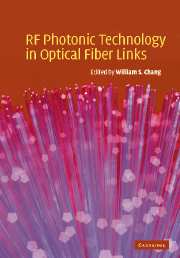Book contents
- Frontmatter
- Contents
- List of contributors
- Introduction and preface
- 1 Figures of merit and performance analysis of photonic microwave links
- 2 RF subcarrier links in local access networks
- 3 Analog modulation of semiconductor lasers
- 4 LiNbO3 external modulators and their use in high performance analog links
- 5 Broadband traveling wave modulators in LiNb03
- 6 Multiple quantum well electroabsorption modulators for RF photonic links
- 7 Polymer modulators for RF photonics
- 8 Photodiodes for high performance analog links
- 9 Opto-electronic oscillators
- 10 Photonic link techniques for microwave frequency conversion
- 11 Antenna-coupled millimeter-wave electro-optical modulators
- 12 System design and performance of wideband photonic phased array antennas
- Index
- References
11 - Antenna-coupled millimeter-wave electro-optical modulators
Published online by Cambridge University Press: 06 July 2010
- Frontmatter
- Contents
- List of contributors
- Introduction and preface
- 1 Figures of merit and performance analysis of photonic microwave links
- 2 RF subcarrier links in local access networks
- 3 Analog modulation of semiconductor lasers
- 4 LiNbO3 external modulators and their use in high performance analog links
- 5 Broadband traveling wave modulators in LiNb03
- 6 Multiple quantum well electroabsorption modulators for RF photonic links
- 7 Polymer modulators for RF photonics
- 8 Photodiodes for high performance analog links
- 9 Opto-electronic oscillators
- 10 Photonic link techniques for microwave frequency conversion
- 11 Antenna-coupled millimeter-wave electro-optical modulators
- 12 System design and performance of wideband photonic phased array antennas
- Index
- References
Summary
Introduction
As the modulation frequency is increased in a traveling wave electro-optic modulator, good performance becomes more and more difficult to realize. There are generally three reasons for this: (1) velocity mismatch, (2) electrode loss, and (3) parasitic inductance and capacitance in the connections to the electrodes. Several schemes have been invented to deal with these limitations, some of which have already been discussed in Chapter 5. In this chapter we introduce a new scheme that offers improvement in all three limiting aspects, but is practical only at very high microwave frequencies. The basic scheme is simple. The transmission line electrodes of the modulator are broken into N sections, and each section is connected to an on-substrate antenna. The array of antennas thus formed is excited by a plane wave incident from the substrate side, as illustrated in Fig. 11.1. The illumination angle is chosen so that the phase velocity from antenna to antenna is the same as the phase velocity of the light in the optical waveguide. This assures velocity matching from segment to segment, even though the phase velocities of RF and optical waves are not matched within a segment. This overcomes limitation (1), so that the modulator may be made as long as desired. While the optical power is now divided by N (at best), the attenuation along each segment is now α L/N compared to α L for a simple modulator of length L with transmission line loss of α nepers/unit length.
- Type
- Chapter
- Information
- RF Photonic Technology in Optical Fiber Links , pp. 335 - 376Publisher: Cambridge University PressPrint publication year: 2002

